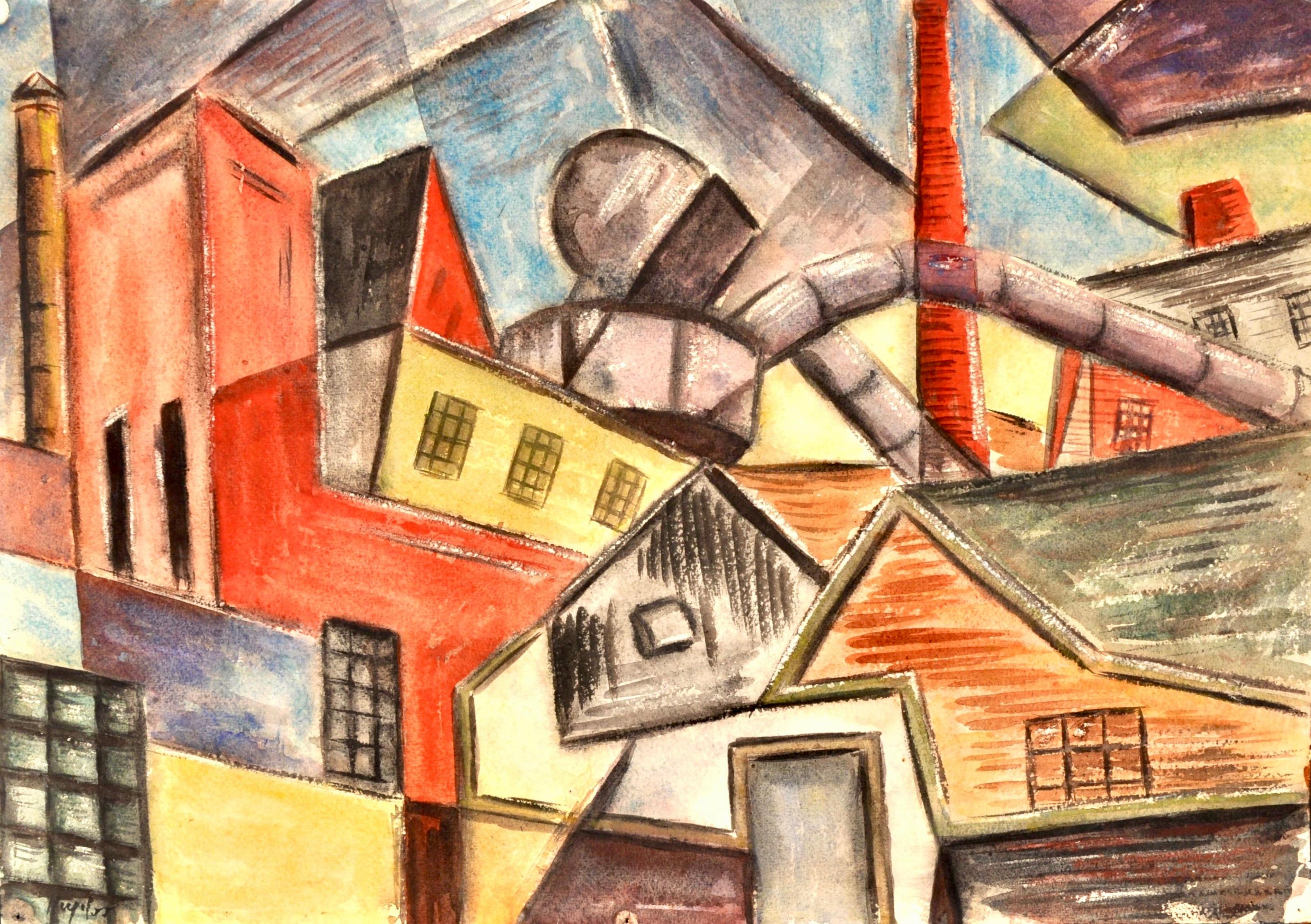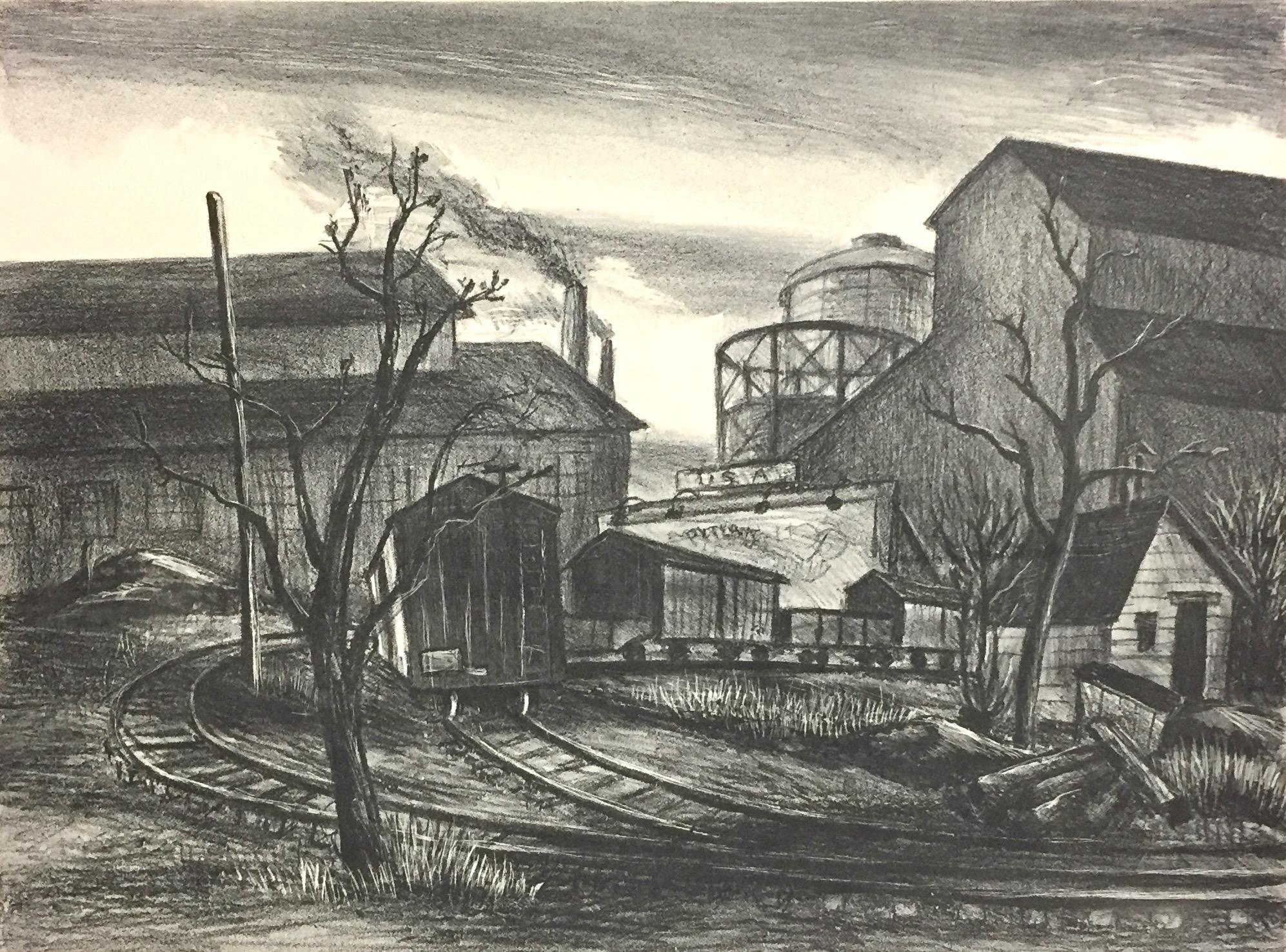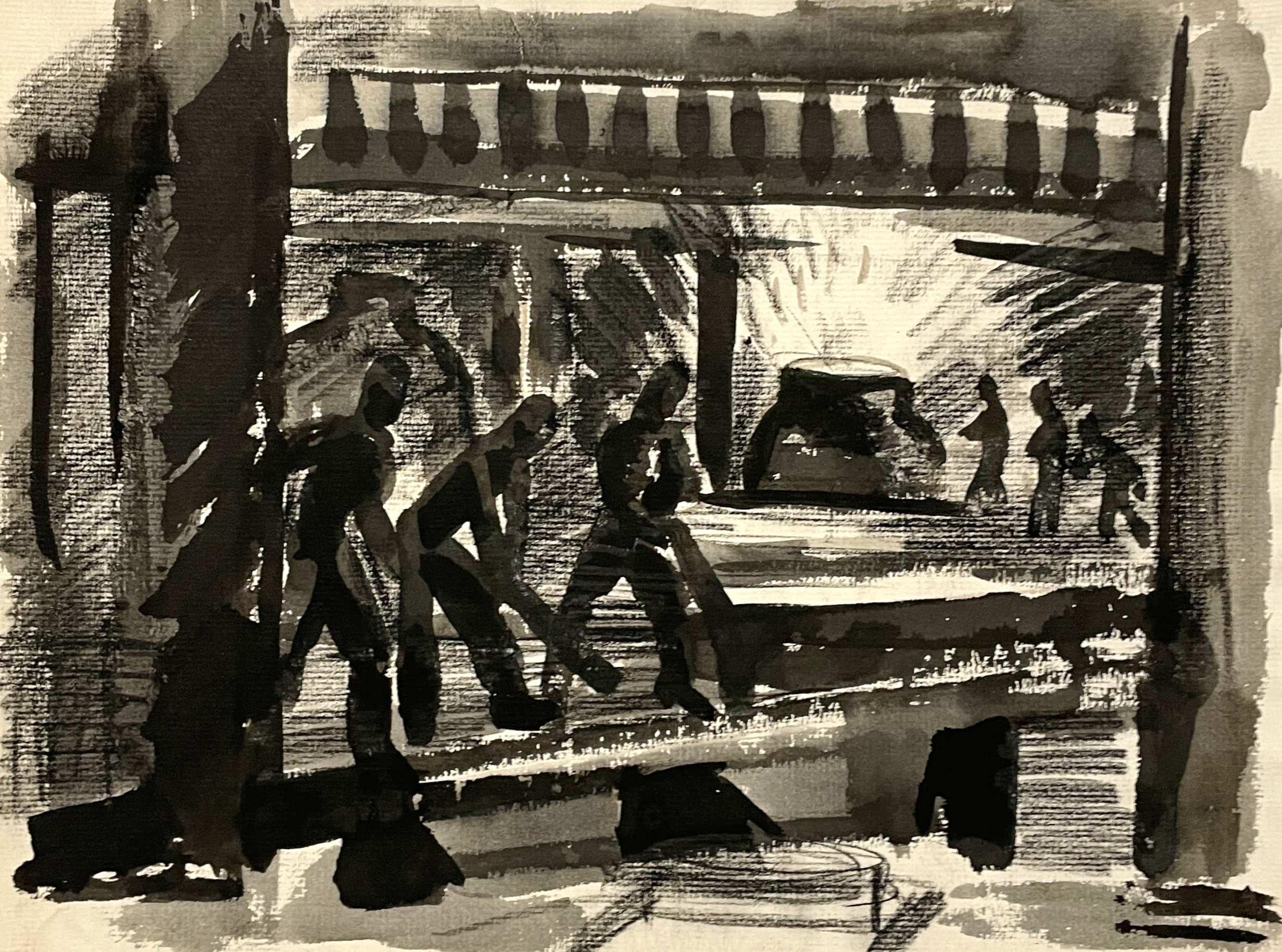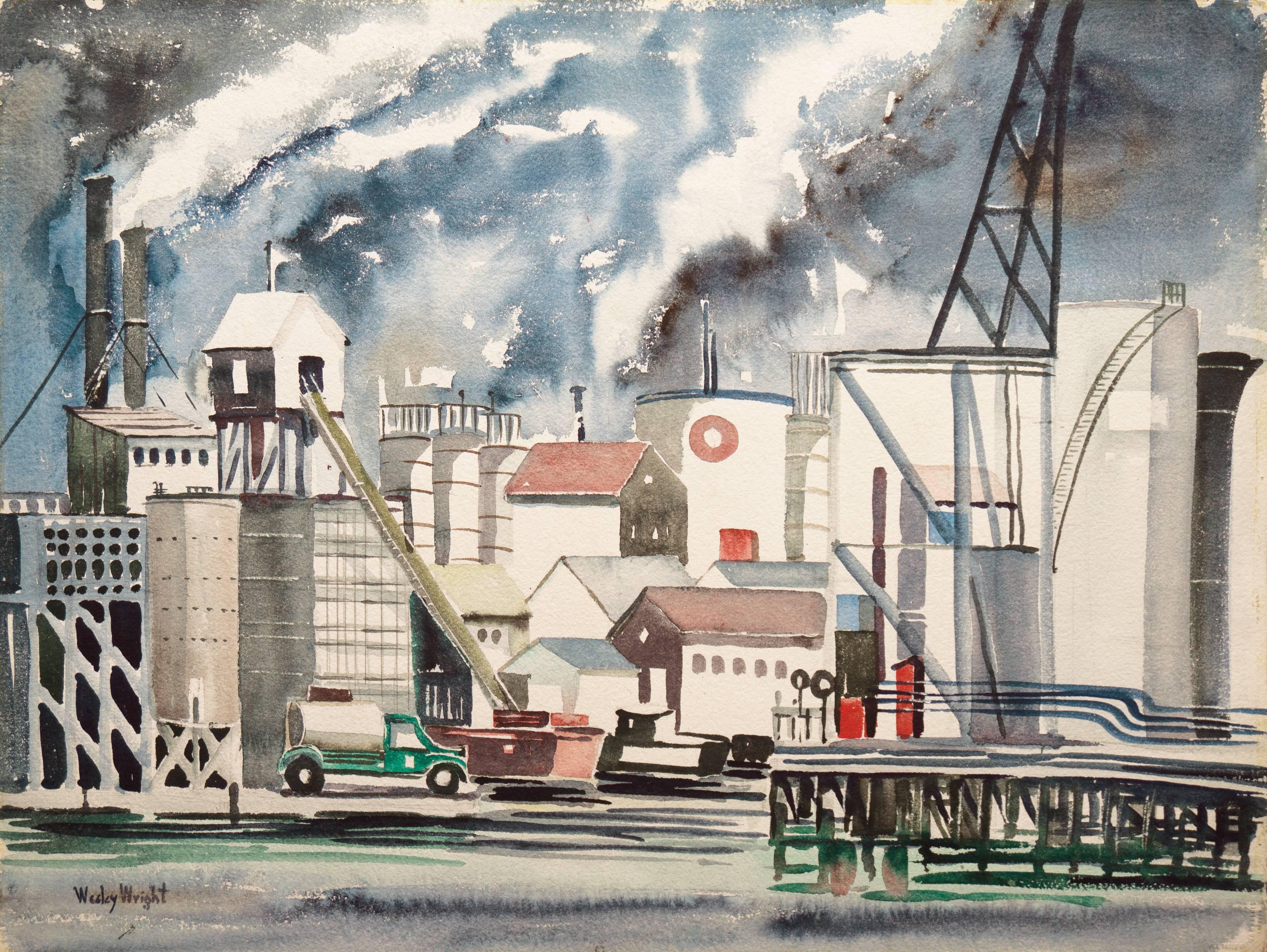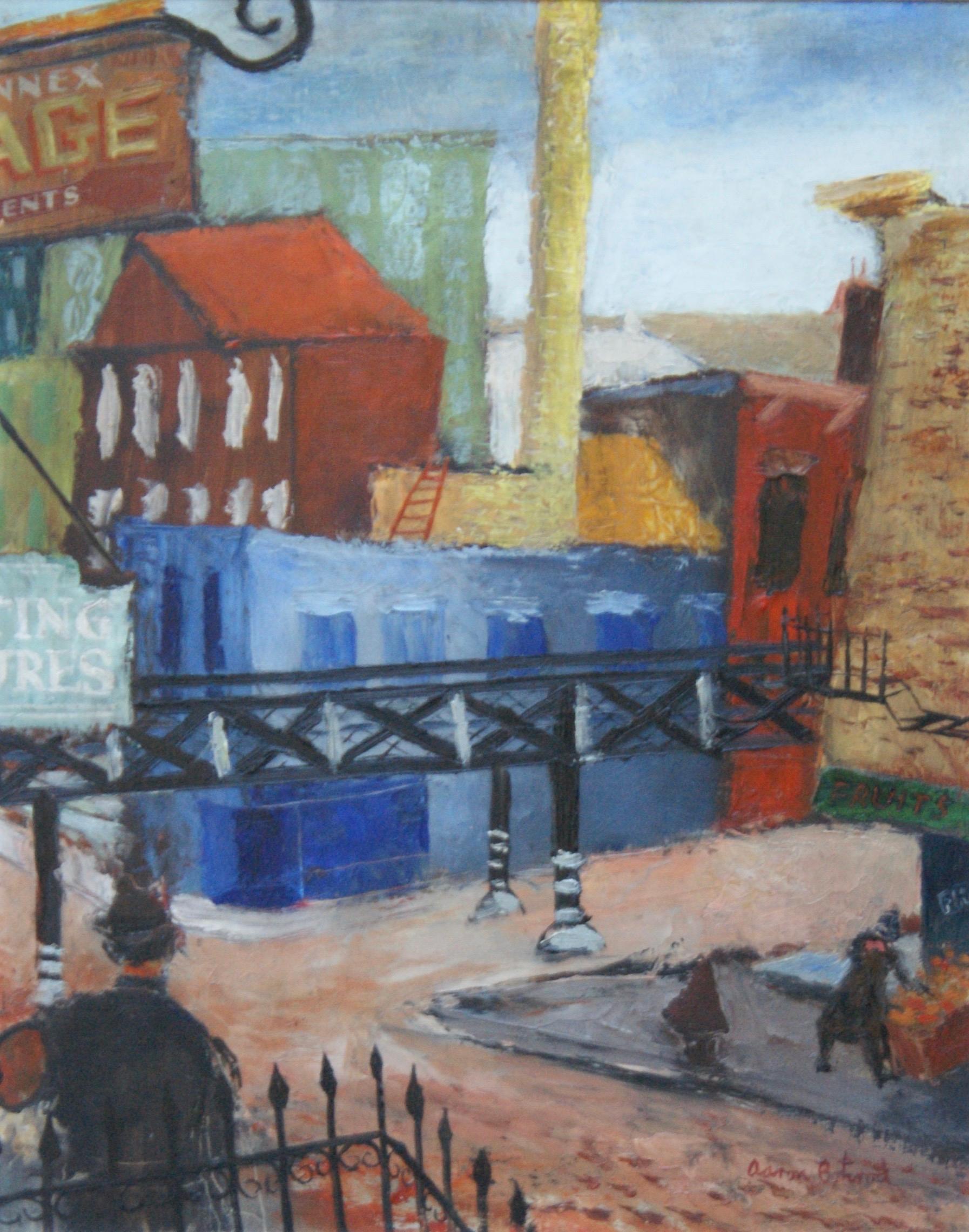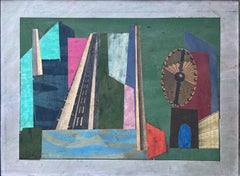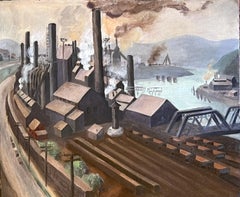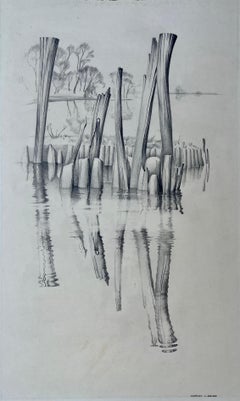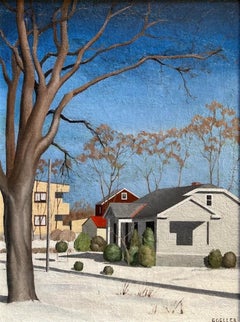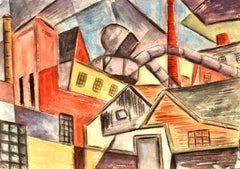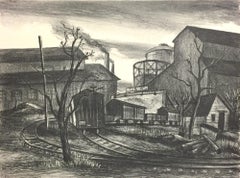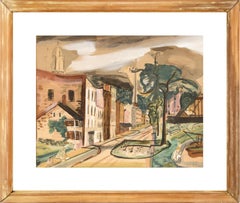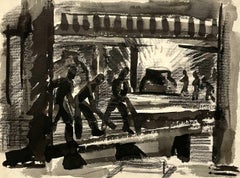Items Similar to Untitled (Industrial Street)
Want more images or videos?
Request additional images or videos from the seller
1 of 5
Edgar CorbridgeUntitled (Industrial Street)
$2,000
£1,519.16
€1,750.59
CA$2,816.50
A$3,122.50
CHF 1,641
MX$38,214.30
NOK 20,494.38
SEK 19,236.02
DKK 13,067.08
About the Item
This work is part of our exhibition - America Coast to Coast: Artists of the 1940s
Untitled (Industrial Street), c. 1940s, watercolor on paper mounted on illustration board, estate stamp verso (signed by Peter Corbridge, the artist’s son); 14 x 21 inches; unframed
Edgar Corbridge was a Massachusetts-based precisionist painter who mainly worked in watercolor. In 1916, three years after immigrating from England, Corbridge completed a course of study in sign painting at the Fall River, Massachusetts Technical High School and obtained an apprenticeship with the Armour Sign Shop. Throughout his career, Corbridge was mainly self-taught as a fine artist. In 1918, Corbridge received his first recognition as an artist for his entry in a Fall River Women’s Club poster competition. During much of his professional life, Corbridge worked as a self-employed window trimmer and operator of the Corbridge Display Service, supplemented by income from the occasional sale of his paintings. Corbridge gleaned the subjects for his works in and around his home in Fall River, Massachusetts, as well as Provincetown. In the 1940s, Corbridge began to exhibit frequently, including at the annual exhibitions at the Jordan Marsh Company in Boston (where he also served as a judge), the Newport Art Association, the Providence Art Club, The Rhode Island School of Design Museum, the Corcoran Gallery, the Portland (Maine) Society of Artists, the Springfield (Massachusetts) Artist League, as well as a number of other institutions. Critics recognized Corbridge for his “extraordinary tonal quality” as well as “clarified, designed reality, which reduces the confusion of nature to fundamental form.” These attributes caused critics, dealers, and collectors to put Corbridge in the precisionist canon, though his works often have a hint of Magic Realism as well. The present work, Untitled (Industrial Street) is a prime example of Corbridge's watercolors, with its meticulous drafting, careful editing and mysterious, depopulated composition which owes a debt to de Chirico. As the 1950s progressed, Corbridge exhibited less, although he participated in the Provincetown Art Association shows consistently through the 50s. Corbridge is listed in Who Was Who in American Art as well as other standard references.
- Creator:Edgar Corbridge (1901 - 1988, American)
- Dimensions:Height: 14 in (35.56 cm)Width: 21 in (53.34 cm)Depth: 1 in (2.54 cm)
- More Editions & Sizes:14 x 21 inchesPrice: $2,000
- Medium:
- Movement & Style:
- Period:
- Condition:
- Gallery Location:Los Angeles, CA
- Reference Number:1stDibs: LU1859214265202
About the Seller
5.0
Vetted Professional Seller
Every seller passes strict standards for authenticity and reliability
1stDibs seller since 2022
15 sales on 1stDibs
Typical response time: <1 hour
- ShippingRetrieving quote...Shipping from: Los Angeles, CA
- Return Policy
Authenticity Guarantee
In the unlikely event there’s an issue with an item’s authenticity, contact us within 1 year for a full refund. DetailsMoney-Back Guarantee
If your item is not as described, is damaged in transit, or does not arrive, contact us within 7 days for a full refund. Details24-Hour Cancellation
You have a 24-hour grace period in which to reconsider your purchase, with no questions asked.Vetted Professional Sellers
Our world-class sellers must adhere to strict standards for service and quality, maintaining the integrity of our listings.Price-Match Guarantee
If you find that a seller listed the same item for a lower price elsewhere, we’ll match it.Trusted Global Delivery
Our best-in-class carrier network provides specialized shipping options worldwide, including custom delivery.More From This Seller
View AllCityscape (Untitled)
Located in Los Angeles, CA
Cityscape (Untitled), c. 1950s, mixed media on board, signed lower left, 13 1/2 x 18 inches, presented in its original frame
Jean (Yanko) Varda was a Greek-born multi-media artist ...
Category
1950s American Modern Mixed Media
Materials
Paper, Oil, Photographic Paper, Board, Magazine Paper
Jones & Laughlin Mills (Untitled)
Located in Los Angeles, CA
Jones & Laughlin Mills (Untitled), 1934, oil on panel, signed lower right, 20 x 24 inches, signed and dated August, 1934 verso, inscribed "Miss Perry" verso, nails from old exhibitio...
Category
1930s American Realist Landscape Paintings
Materials
Oil, Board
Abandoned Wharf
Located in Los Angeles, CA
This drawing is part of our exhibition Charles Goeller: A Wistful Loneliness.
Crayon on paper, 20 x 12 (image), 22 x 14 inches (sheet), Signed lower right, Matted, but not framed
Ex...
Category
1940s American Modern Landscape Drawings and Watercolors
Materials
Crayon, Paper
Suburb (in Winter)
Located in Los Angeles, CA
This painting is part of our exhibition Charles Goeller: A Wistful Loneliness.
Oil on canvas, 20 x 15 inches, Signed lower right
Exhibited:
1) Portrai...
Category
1940s American Modern Landscape Paintings
Materials
Oil
Oil Tanks, Alameda Street, Los Angeles
Located in Los Angeles, CA
Oil Tanks, Alameda Street, Los Angeles, c. 1930-33, watercolor on paper, 14 ¼ x 21 ¼ inches (image), inscribed verso: “watercolor by Ruth Zimmerman 1912 – 1968 / Practice work for sc...
Category
1930s American Modern Landscape Drawings and Watercolors
Materials
Paper, Watercolor
Flood
Located in Los Angeles, CA
This drawing is part of our exhibition Charles Goeller: A Wistful Loneliness.
Crayon on paper, 10 ½ x 9 inches (image), 14 x 11 inches (sheet), Signed...
Category
1930s American Modern Landscape Drawings and Watercolors
Materials
Crayon, Paper
You May Also Like
"Cubist Factory" American Scene WPA Social Realism Mid 20th Century Industrial
Located in New York, NY
"Cubist Factory" American Scene WPA Era Social Realism Mid 20th Century Industrial
Herbert Heyel (American 1907-2000)
"Cubist Factory"
14 x 20 inches
Watercolor on paper, c. 1933
S...
Category
1930s American Realist Landscape Drawings and Watercolors
Materials
Paper, Watercolor
Leonard Pytlak, (Industrial Landscape, New York City)
By Leonard Pytlak
Located in New York, NY
This lithograph is signed and number in pencil. It is numbered 18/18 indicating there were 18 impressions of this subject printed.
Category
1930s Ashcan School Landscape Prints
Materials
Lithograph
"To Market To Market", Early 20th Century Figurative Brooklyn Cityscape
Located in Soquel, CA
"To Market To Market", a whimsical early 20th century modern figurative village landscape by Frank Simon Herrmann (American, 1866-1942). In this charming scene of a downtown village ...
Category
Early 20th Century Modern Landscape Drawings and Watercolors
Materials
Paper, Gouache
WPA Era, Industrial Scene of a Steel Mill by Artist Harold Haydon
By Harold Haydon
Located in Chicago, IL
A ca. 1935 tonal, watercolor of a steel mill by artist Harold Haydon. Artwork size: 8 3/4" x 11 3/4". Archivally matted to 14" x 18". Provenance: Estate of the artist.
Harold E...
Category
1930s American Modern Abstract Drawings and Watercolors
Materials
Watercolor, Paper
$585 Sale Price
31% Off
'Industrial Landscape'
By Wesley Wright
Located in Santa Cruz, CA
Signed lower left, "Wesley Wright", and painted circa 1960.
A substantial, mid-century watercolor view of an industrial area with grain containers and smokestacks.
Category
1950s Landscape Drawings and Watercolors
Materials
Paper, Watercolor
"Industrial Cityscape, Chicago" WPA Modernism Mid-Century Cityscape 20th Century
By Aaron Bohrod
Located in New York, NY
"Industrial Cityscape, Chicago" WPA Modernism Mid-Century Cityscape 20th Century
Aaron Bohrod (American 1907 – 1992)
Industrial Cityscape
20 x 16 inches
Oil on board
Signed lower ri...
Category
1930s American Modern Landscape Paintings
Materials
Oil, Board
More Ways To Browse
Vintage Industrial Art
Modern Industrial Paintings
Providence Art
Vintage Club Posters
Used Industrial Windows
Portland Maine
Newport Rhode Island Paintings
Magic Poster
Boston Vintage Posters
Glean Vintage
Vintage Shop Window Displays
Precisionist Painting
Used Windows Portland
De Chirico Poster
Poster Jordan
Peter Marsh
Lucas Vintage
New England Watercolor
